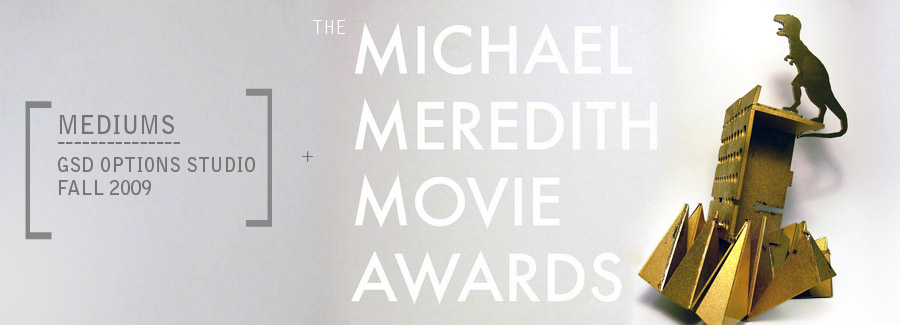Studio Description
Are you tired of ____?
If you answered yes to this question, keep reading.
It could be said that avant-garde production works according to this formula: Medium (technical support) + Convention (artistic genre, typology, history) + Play (improvisation, !@#?) = Architecture. Once you have filtered the history of architecture through this formula, however, it becomes clear that these variables are in constant turmoil. While Convention is perhaps fairly resistant to the anxiety and whimsy of change (though not impervious), Medium remains consistently problematic and has often, especially in recent years, instigated and exacerbated Play. We will be investigating the problems inherent in this understanding of medium and working towards the possibilities of a post-medium condition for architecture.
Architecture still operates for the most part according to the modernist criteria of medium specificity (see Clement Greenberg and Colin Rowe). The notion of medium specificity tells that the work (of art) is successful if it fulfills the promise of the medium used to create that work of art. Currently, there is no shortage of specific mediums for architects to work with: Space or Image or Geometry or Typology or Program or Materiality or Narrative or Figuration or Digital Representation or Algorithms or Digital Fabrication or Experience or Structure or Environmental Systems or Tectonic Expression or Politics, etc. Embedded within each of these instantiations of medium specificity is a specific subjectivity. Armed with these subjectivities, architects see the constraints of Convention and the possibilities for Play refracted and distorted through the specifics of Medium. History, then, can become a geometric problem or a material problem or a programmatic problem, etc. Within this medium subjectivity there develops a symbolic specificity: people who share the same subjectivities, with increasing narrowness, can understand and read the nuanced signifiers and symbols of that medium. Although medium specificity is no longer a dominant idea, architectural discourse has been left with its remnantsthe narrowness and specificity of continually splintering regimesin its current state of disarray.
As architects (especially students) operating today, we do not build the thing we are designing. The act of architecture is fundamentally mediated. This lack of a clear self-image is where architecture is both empowered and weakened. For better or worse, the problem of medium is tied to the problems of representation and methodologythe problem of the blank page, or how to begin. Once you pick your medium, these problems of representation and methodology how you are going to workrely upon an associated discourse and set of referents (Convention) with their own politics and history.
Studio Project:
The hypothesis of the studio is that the problems of medium specificity can be addressed by exacerbating multiple medium specificities into impure, awkward, and paradoxical recombinations. The goal is to be as specific and detailed as possible while assembling a series of competing mediums into a project.
As an open laboratory in search of alternative architectural models, these investigations will be anchored by several texts concerning mediums and the post-medium condition. From there, we will proceed in a hybridized mode of a seminar, group therapy, collaborations with visiting guests (artists, architects, computer programmers, writers) and, most importantly, the development of projects that address the problem of medium. The studio is conceived as the production of a rich and heterogeneous discoursea microcosmic view of experimental, multiple and promiscuous possibilities for contemporary architecture.
Studio participants will develop a highly self-conscious diagramming and working mini-history of at least one medium of their choosing, and, more importantly, an understanding of the modalities of medium itself in general. Site and Program, the usual ingredients of a studio project, are just two of many possible mediums to be considered and understood. Both are characteristics of different perhaps competing architectural regimes. Our site will be The High Line in Manhattan, and the program is a Unitarian church. Additionally, we will investigate interactive processes, animation and film as a methods of architectural representation. These mediums among others will be operating in parallel with each other and at times directly competing with each other. The hierarchies of multiple mediums can be determined either through an absolute hierarchy or a relative one. (For instance, the problems of concrete material construction could trump a perfectly precise algorithmic geometry, etc...) These relationships will be described and mapped out. Through a careful teasing out of mediums, both obvious and latent, we will try to develop an architecture for a post-medium condition, to generate what Rosalind Krauss calls differential specificity through the committed interrogation and recombination of mediums.
